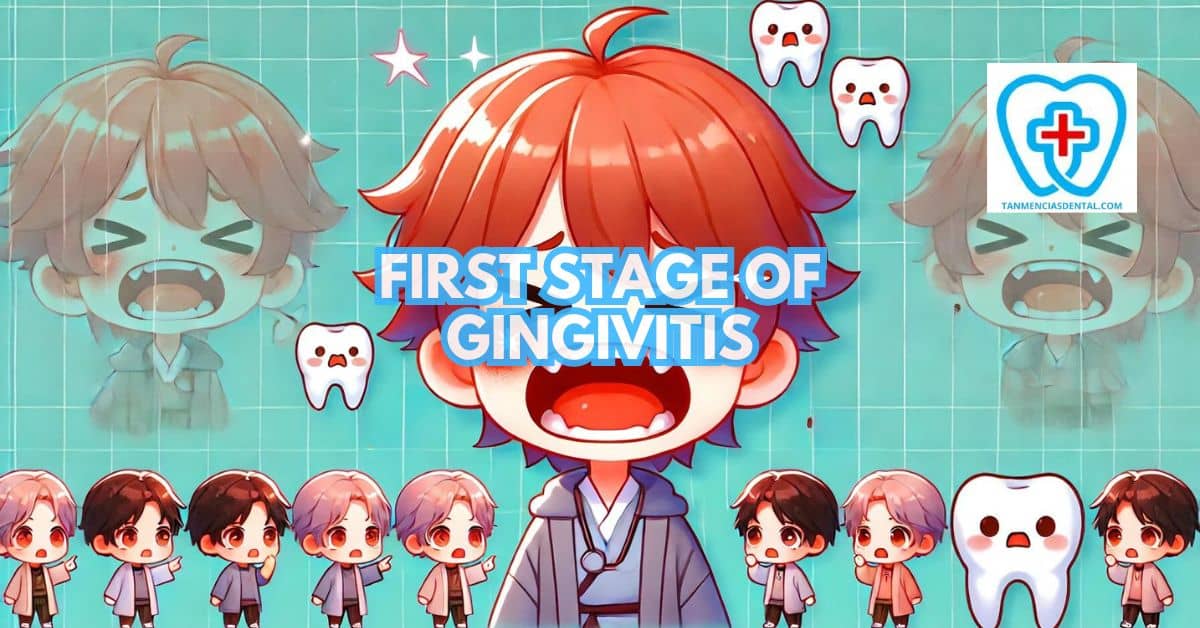Gingivitis is the initial phase of gum disease, marked by gum inflammation.
It occurs due to the buildup of plaque, a sticky film of bacteria on the teeth.
If left untreated, gingivitis can progress to more severe gum diseases, like periodontitis.
Early detection is crucial to reversing the damage and maintaining gum health.
Understanding the causes and symptoms of gingivitis is key to preventing its progression.
1. The Troublemaker: Plaque Buildup and Its Impact on Gums
Plaque forms on your teeth every day from the food you eat and the drinks you consume.
This sticky film harbors bacteria that produce toxins, irritating the gums and leading to inflammation.
If not removed through regular brushing and flossing, plaque hardens into tartar, which further aggravates the gums.
The ongoing irritation from plaque and tartar can cause the gums to become swollen, red, and prone to bleeding, marking the earliest stage of gum disease known as gingivitis.
If left untreated, gingivitis can progress to periodontal disease, causing more severe damage to the gums and supporting structures of the teeth.
Advanced periodontitis, the most severe stage of gum disease, can result in tooth loss and significant oral health problems.
Controlling plaque through consistent oral hygiene practices is essential for preventing gingivitis and maintaining healthy gums, thereby avoiding the progression to more serious conditions like periodontal disease and advanced periodontitis.
🦷 Brushing Away Trouble: Find the Best Toothpaste to Combat Plaque and Gingivitis
2. Warning Signs You Shouldn’t Miss: Early Symptoms of Gingivitis
The first signs of gingivitis are often subtle, making them easy to overlook.
Red, swollen gums that bleed during brushing or flossing are common early symptoms, indicating that the gum line is inflamed.
Persistent bad breath or a bad taste in the mouth can also indicate gingivitis, as bacteria buildup releases unpleasant odors and flavors.
Another warning sign is gum that appears shiny or feels tender to the touch.
These symptoms suggest that the gums are inflamed and require attention to prevent gum disease from progressing.
If left untreated, gingivitis can advance, necessitating more intensive treatments like scaling and root planing to remove plaque and tartar from below the gum line.
Recognizing and addressing these early signs can prevent the condition from worsening, ensuring healthier gums and a brighter smile.
🦷 Brushing with Confidence: Are Electric Toothbrushes Safe for Everyone?
3. Why Early Detection Matters: Preventing Gingivitis from Progressing
Early detection of gingivitis is critical to stopping its progression to a more serious form of gum disease.
If caught early, gingivitis can be reversed with proper oral hygiene and professional dental care, such as cleanings and checkups.
Delaying treatment allows the inflammation to worsen, leading to periodontitis, a severe form of gum disease that affects the tissues and bone supporting the teeth.
If periodontitis develops, it can result in bone loss around the teeth and eventually cause tooth loss.
Regular dental checkups help identify gingivitis in its early stages, allowing for timely intervention.
A periodontist, a specialist in gum diseases, can provide advanced care if gingivitis progresses to periodontitis.
Addressing gingivitis early ensures better oral health, prevents complications like bone loss, and maintains a strong foundation for your teeth.
🦷 Can Electric Toothbrushes Damage Fillings? How to Avoid a Brushing Disaster
4. Beyond Brushing: Flossing for Healthy Gums
Brushing your teeth twice a day is essential, but it isn’t enough to remove all the plaque and food particles.
Flossing daily helps clean between teeth and under the gumline, areas that a toothbrush can’t reach.
Without flossing, plaque can build up in these areas, leading to gum irritation and inflammation.
Proper flossing techniques include using a clean section of floss for each tooth and gently curving the floss around each tooth.
Incorporating flossing into your daily routine is vital for maintaining healthy gums and preventing gingivitis.
🦷 Braces Care 101: Essential Tips for Keeping Your Teeth Clean and Healthy
5. Diet and Oral Health: The Link Between Food Choices and Gingivitis
Your diet plays a significant role in your oral health and can influence the development of gingivitis.
Consuming high amounts of sugary and starchy foods contributes to plaque formation on your teeth.
On the other hand, a diet rich in vitamins and minerals, especially vitamin C and calcium, supports healthy gums.
Drinking plenty of water helps wash away food particles and bacteria, reducing plaque buildup.
Making mindful food choices can help prevent gingivitis and promote overall gum health.
🦷 Mouthwash Before Brushing: Your Ultimate Guide to Making It Work or Avoiding Trouble
6. Don’t Wait: Seeking Dental Help for Early Stage Gingivitis
If you notice early signs of gingivitis, such as bleeding gums or persistent bad breath, don’t delay seeking professional dental care.
A dentist can perform a thorough cleaning to remove plaque and tartar that home care can’t eliminate.
Early intervention can prevent gingivitis from progressing to periodontitis, a more severe gum disease.
Your dentist can also provide personalized advice on improving your oral hygiene routine.
Taking prompt action ensures better gum health and prevents future complications.
🦷 Finding the Perfect Fit: Which Dentist Specializes in Dentures?
7. What to Expect at Your Dental Appointment: Cleaning and Gum Health Assessment
During a dental appointment for gingivitis, the dentist will start with a professional cleaning to remove plaque and tartar buildup.
They will also examine your gums for signs of inflammation and measure the depth of the gum pockets around your teeth.
This assessment helps determine the severity of gingivitis and the necessary treatment.
In some cases, the dentist may recommend more frequent cleanings or additional treatments to manage the condition.
Regular dental visits are crucial for monitoring and maintaining gum health.
🦷 Dentist vs. Oral Surgeon: Who’s the Right Professional for Your Smile Needs?
8. Maintaining a Healthy Smile: Daily Habits for Healthy Gums
To maintain healthy gums and prevent gingivitis, adopt a consistent daily oral hygiene routine.
Brush your teeth twice a day with fluoride toothpaste, ensuring you clean all surfaces of your teeth and gums.
Floss daily to remove plaque and food particles from between your teeth and under the gumline.
Using an antiseptic mouthwash can help reduce bacteria in your mouth and keep your gums healthy.
These habits, combined with regular dental checkups, will help keep your gums in top condition.
🦷 Choosing the Right Dentist for Braces: What You Need to Know
9. Regular Checkups—Your Key to Oral Health: Prevention and Early Detection
Regular dental checkups are essential for preventing gingivitis and detecting it early.
During these visits, your dentist can identify signs of gum disease that you might not notice at home.
Professional cleanings remove plaque and tartar that brushing and flossing can’t reach, reducing the risk of gingivitis.
Your dentist can also provide personalized advice on improving your oral hygiene routine.
Schedule checkups at least twice a year to maintain optimal oral health and catch any issues early.
🦷 Is Your Smile Worth the Cost? Understanding Why Dental Care Can Be Expensive
10. Home Remedies and Professional Treatments: Combining Efforts for Best Results
Combining home care with professional treatments provides the best defense against gingivitis.
At home, maintain good oral hygiene by brushing, flossing, and using mouthwash daily.
Eating a balanced diet and staying hydrated also support gum health.
Regular professional cleanings and checkups enhance the effectiveness of your home care routine.
By combining these efforts, you can effectively prevent and manage gingivitis.
🦷 Root Canal Rescue: Which Dentist Can Help and How They Relieve Your Pain
👨⚕️ Conclusion
Recognizing and addressing the early signs of gingivitis is vital for maintaining healthy gums.
Implement daily oral hygiene practices and visit your dentist regularly for checkups.
Early detection and prompt treatment can prevent gingivitis from progressing to more severe gum disease.
By taking proactive steps, you ensure a healthy smile and better overall oral health.
Don’t ignore the early signs—take action to keep your gums healthy and strong.
😊 Self-Promotion
Visit Tan-Mencias Dental Clinic in Parang, Marikina City, for all your dental care needs!
Our friendly and professional team is dedicated to ensuring your oral health and a bright smile.
You can easily reach us with any questions or to schedule an appointment by calling 9171451074, contacting us via our Facebook page, or using our website’s contact form.
We’re here to help you achieve and maintain a healthy, beautiful smile.
Experience the best in dental care at Tan-Mencias Dental Clinic!

